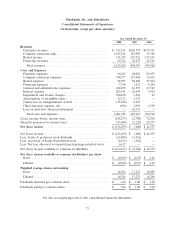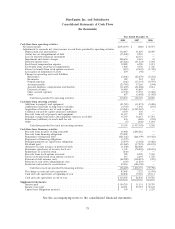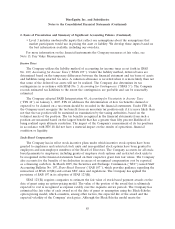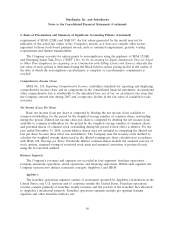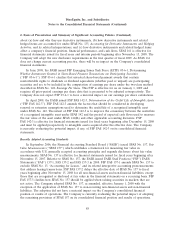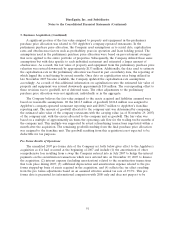IHOP 2008 Annual Report Download - page 95
Download and view the complete annual report
Please find page 95 of the 2008 IHOP annual report below. You can navigate through the pages in the report by either clicking on the pages listed below, or by using the keyword search tool below to find specific information within the annual report.DineEquity, Inc. and Subsidiaries
Notes to the Consolidated Financial Statements (Continued)
2. Basis of Presentation and Summary of Significant Accounting Policies (Continued)
business combination. The excess of the fair value of the reporting unit over the amounts assigned to
its assets and liabilities is the implied fair value of the goodwill, to which the carrying value of the
goodwill must be adjusted. The fair value of all reporting units is then compared to the current market
value of the Company’s common stock to determine if the fair values estimated in the impairment
testing process are reasonable in light of the current market value.
As a result of the impairment review performed in 2008, an impairment of goodwill and intangible
assets was recorded. See Note 7, Impairment and Closure Charges.
Self-Insurance Liability
The Company is self-insured for a significant portion of its employee workers’ compensation,
general liability and health insurance obligations. The Company maintains stop-loss coverage with third
party insurers to limit its total exposure. The accrued liability associated with these programs is based
on historical claims data and our estimate of the ultimate costs to be incurred to settle known claims
and claims incurred but not reported as of the balance sheet date. The estimated liability is not
discounted and is based on a number of assumptions and factors, including historical trends, actuarial
assumptions and economic conditions. If actual trends, including the severity or frequency of claims,
differ from our estimates, our financial results could be impacted.
Revenue Recognition
The Company’s revenues are recorded in four categories: franchise operations, company restaurant
operations, rental operations and financing operations.
The franchise operations revenue consists primarily of royalty revenues, sales of proprietary
products at IHOP, IHOP advertising fees and the portion of the franchise fees allocated to the
Company’s intellectual property. Company restaurant sales are retail sales at company-operated
restaurants. Rental operations revenue includes revenue from operating leases and interest income
from direct financing leases. Financing operations revenue consists of the portion of franchise fees not
allocated to the Company’s intellectual property and sales of equipment as well as interest income from
the financing of franchise fees and equipment leases.
Revenues from franchised and area licensed restaurants include royalties, continuing rent and
service fees and initial franchise fees. Royalties are recognized in the period in which the sales are
reported to have occurred. Continuing fees are recognized in the period earned. Initial franchise fees
are recognized upon the opening of a restaurant, which is when the Company has performed
substantially all initial services required by the franchise agreement. Fees from development agreements
are deferred and recorded into income when a restaurant under the development agreement is opened.
Sales by company-operated restaurants are recognized when food and beverage items are sold.
Company restaurant sales are reported net of sales taxes collected from guests and the sales taxes are
remitted to the appropriate taxing authorities.
In addition, the Company records a liability in the period in which a gift card is issued and
proceeds are received. As gift cards are redeemed, this liability is reduced and revenue is recognized.
The Company recognizes gift card breakage income when the likelihood of the redemption of the gift
card becomes remote.
81




